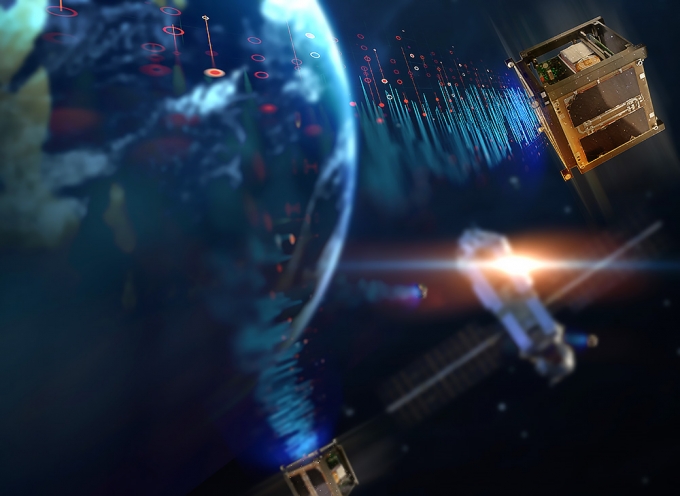If the parts in a satellite, a drone, or other specialized device are large in Size, Weigh a lot, And consume Power inefficiently — in other words, if their SWaP is high — then the device itself has to be bigger, heavier, and more expensive to build, launch, or operate, and that is not desirable. A pair of UC Santa Barbara College of Engineering faculty have received a grant to develop Lidar photonic integrated circuits (PICs) that have ultra-low SWaP and are intended for precise measurements of atmospheric constituents such as carbon dioxide. Lidar is a light-based remote-sensing method that uses a pulsing lasar to map environments.

Associate Professor Jonathan Klamkin and Professor Larry Coldren, both in the Department of Electrical and Computer Engineering, have received one of twelve highly competitive NASA research awards to produce low-SWaP integrated micro-photonic circuits for satellite-based Lidar applications. The three-year award is part of the space agency’s $14 million Advanced Component Technology Program (ACT-17).
“Photonic integrated circuits can reduce SWaP dramatically — by several orders of magnitude — so they can be deployed on smaller spacecraft that cost much less and launch more frequently,” Klamkin said. The upshot is significantly more scientific measurements at substantially reduced cost.
“We are shrinking down a very capable system from the size of a small refrigerator to pocket size, and making it perform even better,” he added. “That opens up a lot of doors, not only for space missions, but for other applications as well. For space specifically, you could map Earth’s carbon dioxide — or methane or other gases — by putting our technology on CubeSats [modular satellites consisting of one or more 10x10x10-cm cubes], which launch often. Today, systems like this don't fit on even large satellites.”

The Lidar PIC will enable spectroscopic measurements of the Earth’s atmosphere with increased sensitivity and enable near-infrared (NIR) multi-wavelength analysis so that a single integrated device can be used to monitor carbon dioxide and other greenhouse gases.
PICs have been highly developed for the telecommunications industry, but those circuits do not meet the requirements for remote sensing Lidar and also haven't been qualified for space. Further, Coldren said, “The level of integration we are applying is well beyond what is available commercially; we are building an entire Lidar sensing system on a single chip, or at most, a few chips. The objective is to realize a pocket-size system for sensing carbon dioxide that can be deployed on small spacecraft.”
Their approach to sensing carbon dioxide, Klamkin adds, “relies on measuring just a small trace of carbon dioxide, which is like trying to find a needle in a haystack. But if you can find it, there are advantages to carrying out measurements from space this way. The approach requires fast, precise, tunable lasers, and we are building on prior work in optical phase-locked loop technology to achieve these metrics.”
The PICs could eventually be qualified for space, thus setting a path for use on future NASA missions, provided they could pass fairly rigorous qualification testing.
“I am particularly excited for the UCSB students and researchers involved,” Klamkin noted. “They will collaborate with world-renowned scientists and engineers at NASA to develop very important technology that may one day fly into space.”
Both Klamkin and Coldren are experts in integrated photonics and are affiliated with the UCSB–based West Coast Hub of the American Institute for Manufacturing Integrated Photonics (AIM Photonics), a federally funded Institute for Manufacturing Innovation. They will collaborate with Lidar experts at the NASA Goddard Space Flight Center (GSFC), who have previously successfully built and flown instruments using discrete components.
Professor Klamkin is currently working on two other NASA grants in collaboration with the Lasers and Electro-Optics Branch at NASA GSFC: The Early Career Faculty Space Technology Research Grant on Low SWaP Lasers for Deep Space Communications, and the Early Stage Innovations Award on Integrated Photonics for Low-Earth Orbit Space Optical Communications. He is also working with the Communications and Intelligent Systems Division at NASA Glenn Research Center on an Early Stage Innovations Award on Integrated Photonics for Extreme High Frequency Band Space Applications.

